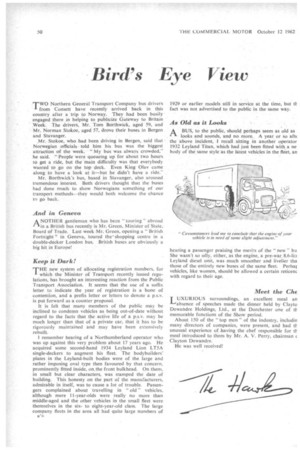Bird's Eye View
Page 52

If you've noticed an error in this article please click here to report it so we can fix it.
TWO Northern General Transport Company bus drivers from Consett have recently arrived back in this country after a. trip to Norway. They had been busily • engaged there in helping to publicize Gateway to Britain ,Week: The drivers, •Mr. 'Torn .Borthwick, aged 59. and -Mr. Norman Stokoe,• aged 57, drove their buses in Bergen and Stavanger. ,Mr. Stokoe, who had been driving in Bergen, said that Norwegian ,officials, told him his bus was the biggest attraction of the week: "My bus was always crowded,he said. " People were qUeueing up for about two hours to get a ride, but the main difficulty was that everybody wanted to go on the top deck. Even King Olav came along to have a look at it—but he didn't have a ride.
Mr. Borthwick's bus, based in Stavanger, also aroused tremendous interest. Both drivers thought that the buses had done much to show Norwegians something of our transport methods--they would both welcome the chance to go back.
And in Geneva
A NOTHER gentleman who has been "touring abroad r-lin a British bus recently is Mr: Green, Minister of State, Board of Trade. Last week Mr. Green, opening a "British Fortnight in Geneva, toured the' shopping centre in a double-decker London bus. British buses are obviously a big hit in Europe!
Keep it Dark!
THE new system of allocating registration numbers, for I which the Minister of Transport recently issued regulations, has brought an interesting reaction from the Public Transport Association. It seems that the use of a suffix letter to indicate the year of registration is a bone of contention, and a prefix letter or letters to denote a p.s.v. is put forward as a counter proposal
It is felt that many members of the public may be inclined to condemn vehicles as being out-of-date without regard to the facts that the active life of a p.s.v. may be much longer than that of a private car, that it has to be rigorously maintained and may have been extensively rebuilt.
remember hearing of a Northumberland operator who was up against this very problem about 17 years ago. He acquired some second-hand 1934 Leyland Lion LT5A single-deckers to augment his fleet. The bodybuilders' plates in the Leyland-built bodies were of the large and rather imposing oval type then favoured by that concern, prominently fitted inside, on.the front bulkhead. On them, in small but clear characters, was stamped the date of building. This honesty on the part of the manufacturers, admirable in itself, was to cause a lot of trouble. Passengers complained about travelling in " old " vehicles, although mere 11-year-olds were really no more than middle-aged and the other vehicles in the small fleet were themselves in the sixto eight-year-old class. The large company fleets in the area all had quite large numbers of
Fr.(-• 1929 or earlier models still in service at the time, but ti fact was not advertised to the public in the same way.
As Old as it Looks
A BUS, to the public, should perhaps seem as old as I-1looks and sounds, and no more. A year or so aftt the above incident, I recall sitting in another operator 1932 Leyland Titan, which had just been fitted with a ne body of the same style as the latest vehicles in the fleet, an
hearing a passenger praising the merits of the "new" bu She wasn't so silly, either, as the engine, a pre-war 0.6-liti Leyland diesel unit, was much smoother and livelier tha those of the entirely new buses of the same fleet. Perhat vehicles, like women, should be allowed a certain reticenc with regard to their age.
Meet the Che LUXURIOUS surroundings, an excellent meal an -1-Jabsence of speeches made the dinner held by Clayte Dewandre Holdings, Ltd., at the Dorchester one of tf memorable functions of .the Show period. About 150 of the "top men" of the industry, includir many directors of companies, were present, and had tF unusual experience of „having the chef responsible for tlmeal introduced to them by Mr. A. V. Perry, chairman t Clayton Dewandre.
He was well received!




















































































































